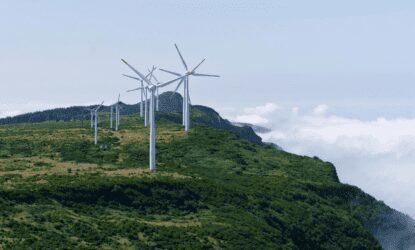 4 practical steps to implement ISO20400
4 practical steps to implement ISO20400
“Life cycle assessments are a key tool to enable the implementation of circular economy strategies and achieve effective decarbonisation for electronics producers.“
Electronics are integral to many areas of modern life, but their production, distribution and use have significant environmental impacts – from the mining and extraction of raw materials to the emissions associated with manufacturing and distribution. Indeed, with the growing demand for technology in both consumer and business applications, addressing the industry’s environmental footprint has never been more urgent.
However, achieving this requires a thorough understanding of how electronic products impact the environment throughout their life cycle. This makes life cycle assessment (LCA) an essential methodology for companies looking to implement circular economy principles and accelerate their decarbonisation strategy. Below, we explore how life cycle analysis can support improved product sustainability for electronics.
What are the challenges of life cycle assessment in the electronics industry?
Digital technologies are estimated to be responsible for between 1.4% and 5.9% of total global greenhouse gas (GHG) emissions,2 meaning that achieving net zero is a priority for many in the industry. However, measuring and reducing the environmental impact of electronics is particularly challenging due to three key factors:
- Product complexity – electronic devices contain hundreds of different components, making it difficult and time-consuming to conduct a comprehensive life cycle assessment.
- Material diversity – even everyday devices require a wide range of raw materials, including rare and precious metals from around the world.
- Recycling challenges – many electronic components are difficult to recover and repurpose efficiently, exacerbating the industry’s carbon footprint.
By providing clarity on the source and scale of emissions and other environmental impacts throughout the electronics value chain, life cycle assessment is an essential tool for measuring and addressing the sector’s significant environmental impacts.
Life cycle assessment in action: The impact of a single smartphone
A typical smartphone contains a wide range of components, including processors, memory chips, sensors, cameras and displays. Each of these elements has its own complex supply chain and manufacturing process. To implement an effective decarbonisation strategy, companies must collect, analyse and act on LCA data to identify environmental impact hotspots and drive sustainable innovation. A comprehensive life cycle assessment will examine GHG emissions and other impacts across multiple product life cycle stages in addition to manufacturing, including:
- Raw material extraction e.g. mining of silicon (for semiconductors), gold (for wiring), copper, aluminium and rare earth metals.
Alongside producing significant GHG emissions, mining is typically highly water-intensive, consuming large volumes for mineral separation and dust suppression. It can also contribute to land-use change and deforestation, particularly in tropical regions where rare metals are extracted. Other impacts include soil erosion, habitat destruction and chemical pollution from tailings and heavy metals that can contaminate nearby ecosystems and groundwater.
- Supply chain emissions e.g. transportation of components to assembly facilities and distribution to stores and e-commerce customers.
Beyond direct carbon emissions from fuel combustion, global logistics can involve packaging waste, noise pollution, and increased road and air congestion, which can strain urban infrastructure. Dependence on air freight for just-in-time delivery can further escalate emissions and fuel demand.
- Usage phase e.g. electricity consumption throughout the lifetime of the device.
In addition to GHG emissions from electricity use, the use phase can involve surges in energy demand due to increasing application complexity, network infrastructure and data storage via cloud services. This phase also contributes to indirect impacts such as the need for expanded data centre capacity, which can result in additional land use, water cooling requirements and biodiversity disruption.
- End-of-life processing e.g. emissions from collection, recycling and material recovery activities.
E-waste processing can release toxic substances such as lead, mercury and brominated flame retardants, particularly in informal recycling sectors. Processes can also involve energy-intensive operations, residual waste generation and exposure risks for workers. Improper disposal contributes to landfill expansion, soil contamination and marine pollution from microelectronics.
With such a wide range of sustainability risks, electronics companies need to take a comprehensive view of their impacts. By leveraging LCA insights, manufacturers and sustainability professionals can identify emissions hotspots, improve resource efficiency and implement circular economy principles – paving the way for a more sustainable electronics industry.
How can a life cycle assessment drive your decarbonisation strategy?
How we can support
Understanding your product’s environmental footprint is vital to driving sustainable innovation and meeting evolving regulatory demands. Nexio Projects was recognised by Verdantix and Consultancy.eu as among the top ESG consulting firms globally. As a trusted partner to clients across chemicals, consumer goods and manufacturing, we offers tailored LCA and product sustainability services to support your transformation.
With experience across more than 25 industries and 400+ clients, our consultants turn technical analysis into actionable business decisions.
Earlier this year, we conducted an LCA for a client in the electronics sector. The primary objective was to assess the carbon footprint of one product and identify key impact hotspots within their production processes.
The results showed that while certain components, such as printed circuit boards (PCBs), capacitors, LCD screens and batteries, made up only a small proportion of the product’s total weight, they were responsible for a significant proportion of the GHG emissions during manufacturing. For example, the PCB alone accounted for 45% of the manufacturing-related emissions, despite accounting for less than 4% of the product’s total weight. By helping to identify such emission hotspots in the value chain, LCAs play a critical role in enabling a targeted decarbonisation strategy.
Finding the ‘why’: How life cycle assessment reveals impact hotspots
Despite being small in size, electrical components such as PCBs require large amounts of resources, resulting in high environmental impacts. This is partly because they rely on materials such as gold, silver and copper, all of which have significant ‘embodied emissions’ due to mining and refining processes. For example, primary gold (from non-recycled sources) has an embodied carbon emission of over 480kg CO2e per gramme.
Another reason why PCBs are so carbon-intensive is the high environmental cost of producing silicon semiconductor wafers, which is highly energy-intensive and involves many complex steps1. These include silicon purification (which requires temperatures in excess of 1,500ºC) and processing the silicon into wafers using high-tech machinery. The assembly of components is also energy-intensive in itself. So, how can LCAs be used to help decarbonise the electronics sector?
Leveraging circular economy principles to accelerate your decarbonisation strategy
One of the greatest challenges for electronics companies seeking to decarbonise is addressing upstream supply chain emissions, particularly those from second- and third-tier suppliers. These suppliers are often outside a company’s direct control, making it difficult to influence their sustainability management, such as energy sourcing decisions. In addition, embodied emissions from the extraction and processing of raw materials remain largely unavoidable without a fundamental shift in approach. This is where circular economy principles can offer a transformative solution.
By focusing on sustainable material use and resource efficiency, circular practices provide a holistic framework for reducing emissions across the value chain. For example, recycled materials typically generate significantly lower carbon emissions compared to virgin alternatives, presenting a clear opportunity to reduce reliance on emissions-intensive material extraction.
In addition, embedding ‘design for circularity’ strategies – such as modular product design – enables longer device lifespans, simpler component replacement and enhanced material recovery at the end-of-life stage. These approaches reduce the ‘life cycle carbon footprint’ of electronic products while also supporting waste reduction. By integrating circular economy thinking into product development and procurement, companies can therefore unlock meaningful climate change mitigation opportunities while building more resilient, sustainable supply chains.
Delivering a viable circular transition: The critical role of life cycle assessment in your decarbonisation strategy
With a wide range of impact-reduction options available, selecting the right decarbonisation interventions is essential to ensure both a positive environmental impact and economic viability. This is where life cycle assessment (LCA) plays a pivotal role.
Life cycle assessment provides a data-driven framework to identify emissions hotspots across a product’s life cycle, enabling manufacturers to pinpoint where changes – such as material substitutions, design improvements or process optimisations – will yield the most significant carbon reductions. This insight allows companies to quantify and compare the potential benefits of different strategies, supporting alignment with science-based targets and broader net-zero goals.
In addition to assessing current environmental impacts, LCA allows organisations to evaluate the future impact of potential interventions, guiding informed decision-making across product development, sourcing and supply chain management.
Furthermore, LCAs can enhance transparency and accountability, enabling clear communication of environmental performance to customers, regulators and investors – building trust and demonstrating your company’s commitment to sustainability.
Frequently asked questions
What is an LCA and why should companies conduct one?
A Life Cycle Assessment (LCA) evaluates the environmental impact of a product or service from cradle to grave, helping companies understand hotspots, reduce risks, and design more sustainable offerings.
How do companies interpret LCA results to drive decision-making?
Companies use LCA results to prioritise interventions, such as material substitutions, design for circularity, or supply-chain optimisation—and integrate findings into product strategy and disclosures.
What boundaries should an LCA include to be robust?
A robust LCA covers relevant life-cycle stages (raw material, manufacturing, use, end-of-life), uses credible data, clarifies system boundaries, and applies recognised standards like ISO 14040/44.
How can LCA insights support sustainability reporting and labels?
LCA data strengthen sustainability reports and help companies meet disclosure frameworks and eco-label requirements by providing quantified evidence of impacts across lifecycle stages.
What are the common pitfalls when leveraging LCA for product sustainability?
Common pitfalls include relying on outdated or generic data, ignoring end‐of‐life phases, failing to engage suppliers for primary data, and treating LCA as a one-off rather than an iterative strategy tool.
Ready to accelerate your decarbonisation strategy through life cycle assessment?
Companies pursuing decarbonisation in the electronics industry face a wide range of challenges and opportunities. At Nexio Projects, we specialise in leveraging LCA insights to identify carbon hotspots and implement effective decarbonisation strategies aligned with circular economy principles.
Whether you need to measure the carbon footprint of your product portfolio using LCAs or identify key strategies to accelerate your net-zero strategy, our experts are here to guide you. Together, we can develop innovative solutions that can help drive progress on your sustainability management while strengthening your business.
Understanding the environmental impact of your products is crucial for sustainable development. Subscribe to our newsletter for ongoing news and insights on product sustainability.
Want to find out more about using life cycle assessment to accelerate your decarbonisation strategy? Explore our product sustainability service page or contact us today for a free consultation with a Nexio Projects expert.
References:
- U.S. Environmental Protection Agency. (2005). Solders in electronics: A life-cycle assessment. https://www.epa.gov/sites/default/files/2013-12/documents/lead_free_solder_lca_full.pdf
- Sharma, A., Bhaskar, K., & Kumar, D. (2024). Driving sustainable circular economy in electronics: A review on life cycle assessment of e-waste management. Environmental Pollution, 330, 122687. https://doi.org/10.1016/j.envpol.2023.122687
- Ji, M., Wang, Y., & Xu, Q. (2024). Life cycle assessment (LCA) of circular consumer electronics based on printed circuit boards. Scientific Reports, 14, Article 2781. https://doi.org/10.1038/s41598-024-79732-1
- Fedorova, M. (2023, April 27). Methodology of life cycle assessment for the electronics industry [Conference presentation]. CERN Environmental Protection Conference, Geneva, Switzerland.
- U.S. Environmental Protection Agency. (2019). Documentation for greenhouse gas emission and energy factors used in the Waste Reduction Model (WARM): Electronics (Version 15). https://www.epa.gov/sites/default/files/2019-06/documents/warm_v15_electronics.pdf











